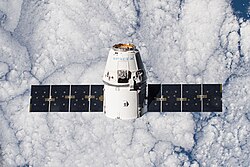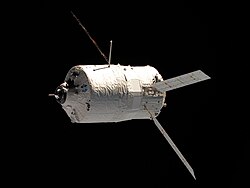Progress M-16M
| Progress M-16M (Прогресс М-16M) | |||
 | |||
| Tillverkare | RSC Energia | ||
|---|---|---|---|
| Modell | Progress-M 11F615A60 | ||
| Färdens tid | 191 dagar, 20 timmar | ||
| NSSDC-ID | 2012-042A[1] | ||
| Uppskjutning | |||
| Startplats | Kosmodromen i Bajkonur 1/5 | ||
| Raket | Sojuz-U | ||
| Uppskjutning | 1 augusti 2012, 19:35:13 UTC | ||
| Återinträde | |||
| Återinträde | 9 februari 2013, 17:05 UTC | ||
| Omloppsbana | |||
| Banlutning | 51,6° | ||
| Varv | 2 979 st[2] | ||
| Dockning | |||
| Rymdstation | ISS | ||
| Dockning | 2 augusti 2012, 01:18 UTC | ||
| Dockningsport | Pirs, nadir | ||
| Ur dockning | 9 februari 2013, 13:16 UTC | ||
| Tid dockad | 191 dagar, 11 timmar, 57 minuter | ||
| Kronologi | |||
| |||
Progress M-16M (ryska: Прогресс М-16M) eller som NASA kallar den, Progress 48 eller 48P, var en rysk obemannad rymdfarkost som levererade förnödenheter, syre, vatten och bränsle till rymdstationen ISS. Den sköts upp med en Sojuz-U-raket från Kosmodromen i Bajkonur den 1 augusti 2012 och dockade med ISS den 2 augusti.
Farkosten slog rekord i kortast tid mellan uppskjutning till dockning, knappt 6 timmar. Att jämföra med de cirka 50 timmar som är brukligt för Progress.
Farkosten lämnade rymdstationen den 9 februari 2013 och brann upp i jordens atmosfär några timmar senare.
Källor
Fotnoter
- ^ ”NASA Space Science Data Coordinated Archive” (på engelska). NASA. https://nssdc.gsfc.nasa.gov/nmc/spacecraft/display.action?id=2012-042A. Läst 1 mars 2020.
- ^ Manned Astronautics - Figures & Facts Arkiverad 5 oktober 2015 hämtat från the Wayback Machine., läst 15 juli 2016.
| |||||||||||||||||||||||||
| ||||||||||||||||||||||||||||||||
| ||||||||||||||||
Media som används på denna webbplats
This image, photographed by one of the Expedition 42 crew members aboard the International Space Station, shows the SpaceX Dragon cargo craft approaching on Jan. 12 2015 for its grapple and berthing and the start of a month attached to the complex. Dragon carried more than 2 ½ tons of supplies and experiments to the station.
Partially obstructed by two Russian spacecraft in the foreground, Tropical Storm Leslie is clearly seen in the Atlantic Ocean on Sept. 9, 2012, as photographed by one of the Expedition 32 crew members aboard the International Space Station. At the time of the photo, Leslie was centered near 33.4 degrees north latitude and 62.1 degrees west longitude (approximately 175 miles east-northeast of Bermuda) moving northward at 14 miles per hour with winds of 60 miles per hour.
ISS021-E-017623 (30 Oct. 2009) --- Backdropped by a cloud-covered part of Earth, the unpiloted Japanese H-II Transfer Vehicle (HTV), filled with trash and unneeded items, departs from the International Space Station. European Space Agency astronaut Frank De Winne, Expedition 21 commander; NASA astronaut Nicole Stott and Canadian Space Agency astronaut Robert Thirsk, both flight engineers, used the station's Canadarm2 robotic arm to grab the HTV cargo craft and unberth it from the Harmony node's nadir port. The HTV was successfully unberthed at 10:18 a.m. (CDT) on Oct. 30, 2009, and released from the station's Canadarm2 at 12:32 p.m.
A Progress supply ship linked up to the orbiting International Space Station (ISS) at 3:48 GMT, November 18, bringing Expedition 1 commander William M. Shepherd, pilot Yuri P.
Gidzenko and flight engineer Sergei K. Krikalev two tons of food, clothing, hardware and holiday gifts from their families. The photograph was taken with a 35mm camera and the film was later handed over to the STS-97 crew members
for return to Earth and subsequent processing.Backdropped by a cloud-covered part of Earth, the Orbital Sciences' Cygnus cargo craft approaches the International Space Station, photographed by an Expedition 40 crew member. The two spacecraft converged at 6:36 a.m. (EDT) on July 16, 2014.
ISS Progress cargo spacecraft (NASA)
An unpiloted Progress 11 supply vehicle departs from the Pirs Docking Compartment on the International Space Station (ISS) at 2:42 p.m. (CDT) on September 4, 2003 for another month alone in orbit, as part of a Russian scientific experiment. It will then be deorbited with its load of trash and unneeded equipment and burn in the Earth's atmosphere.
ISS026-E-037172 (24 Feb. 2011) --- Surrounded by the blackness of space, the European Space Agency's "Johannes Kepler" Automated Transfer Vehicle-2 (ATV-2) approaches the International Space Station. Docking of the two spacecraft occurred at 10:59 a.m. (EST) on Feb. 24, 2011.













